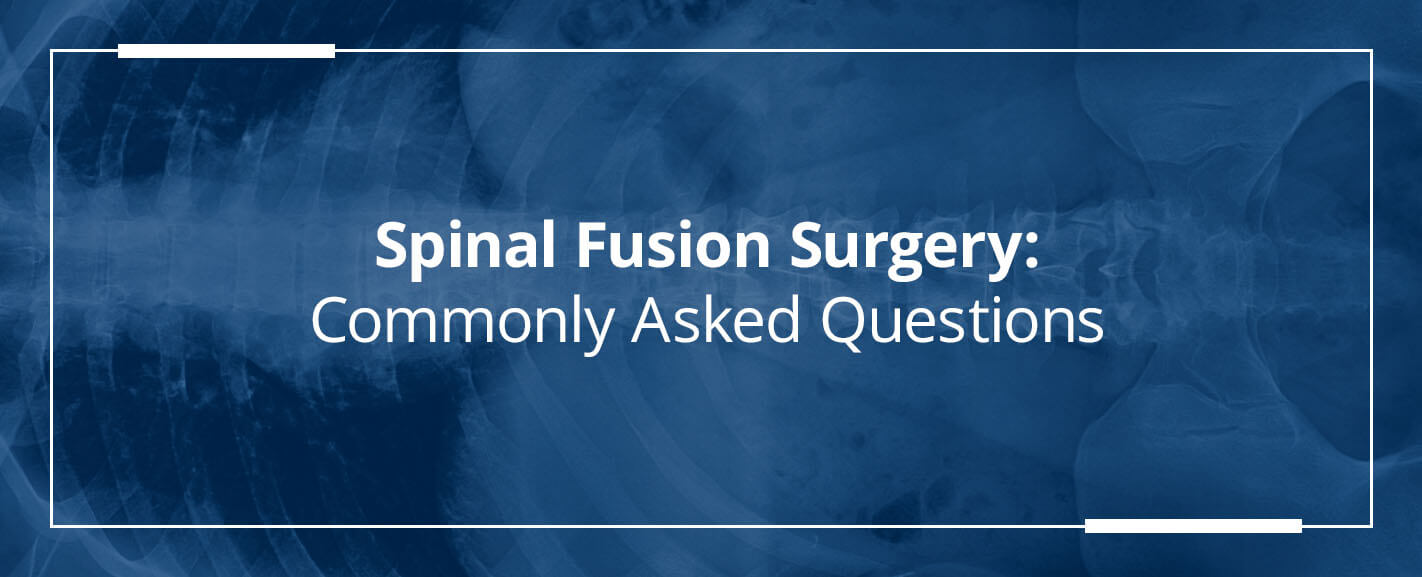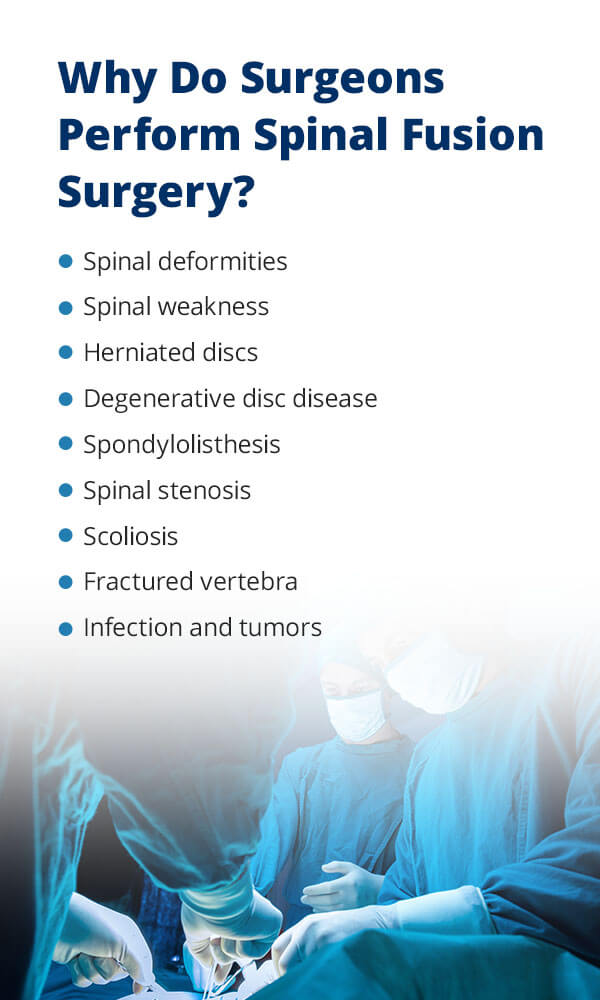
The spinal column consists of the vertebrae, a series of 24 small bones. Between each vertebra, the intervertebral disks form joints and protect the vertebrae from coming into contact with one another. Numerous spinal conditions can cause the intervertebral disks to diminish and cause pain. Spinal fusion can help treat these conditions and improve the associated pain and discomfort.
What Is Spinal Fusion Surgery?

Spinal fusion surgery can permanently connect or fuse two or more vertebrae, reducing the motion between them. During spinal fusion surgery, surgeons use innovative techniques to mimic the body’s natural healing cycle and process of correcting broken bones. Fusing two or more vertebrae can improve stability and correct a painful spinal deformity or complication.
What Happens During Spinal Fusion Surgery?
When surgeons perform spinal fusion surgery, general anesthesia is necessary to ensure patient comfort and safety. A surgeon may use numerous techniques, and they’ll explain their chosen method before your surgery. Typically, a spinal surgeon will consider factors such as the reason for the surgery, the location of the affected vertebrae and your general health in selecting the best approach. While each procedure is unique, there are generally four primary steps to spinal fusion surgery.
- Initial incision: The beginning of spinal fusion surgery involves an incision to gain access to the vertebrae. The incision placement will primarily depend on the location of the vertebrae this surgery is fusing.
- Bone graft: Surgeons use a bone graft to fuse two or more vertebrae. The bone graft material may come from a donor or your pelvis.
- Vertebrae fusion: To permanently fuse the vertebrae, a spinal surgeon will place the bone grafting material between each vertebra. Metal plates and screws may help stabilize the vertebrae and hold them in place while the bone graft heals following surgery.
- Incision closure: As your spinal surgeon approaches the end of your spinal fusion surgery, they’ll close the initial incisions to allow for healing.
What to Expect After Spinal Fusion Surgery
You will need to spend the first few days after spinal fusion surgery recovery in the hospital for observance. While the length of your hospital stay will vary depending on your surgery’s unique details, most patients stay two to three days. As you begin healing, pain and discomfort are likely, but medication can ease them.
When you go home from the hospital, you must follow all postoperative instructions provided to you. Rest and quiet are valuable aspects to healing and recovering properly. If you experience any severe side effects, contact your surgeon immediately. It is also vital to stay alert for potential signs of infection, including wound drainage, shaking, chills, high fever, redness and inflammation. The vertebrae will need several months to heal and fully fuse.
Why Do Surgeons Perform Spinal Fusion Surgery?

Spinal fusion surgery is a versatile treatment that can improve many back and spinal column conditions. In most cases, your physician will only recommend spinal fusion surgery when they can pinpoint the source of your back pain and determine if it relates to specific vertebrae. Before considering spinal surgery, your doctor may order imaging tests to help locate the origin of your back pain. Spinal fusion surgery can treat the following conditions.
- Spinal deformities: Spinal fusion surgery can help improve spinal deformities related to the vertebrae. If there is a considerable distance between two or more vertebrae or a vertebra is not in the correct place, your surgeon can fuse these vertebrae to correct this spinal deformity.
- Spinal weakness: Weakness of the spine relates to excess movement in the vertebrae that causes spinal instability. Spinal fusion can help stabilize the spine and reduce this motion.
- Herniated discs: Some patients with a herniated disc may need to have it removed to improve painful symptoms. Following the removal of a herniated disc, spinal fusion surgery can stabilize the spine.
- Degenerative disc disease: Degenerative disc disease is an age-related condition where one or more intervertebral discs degenerate and break down. A surgeon can perform spinal fusion surgery to prevent the vertebrae from painfully grinding against one another.
- Spondylolisthesis: Spondylolisthesis is a spinal condition that can cause pain and discomfort in the lower back. This condition occurs when one of your vertebrae slips out of its place and onto the vertebra below it. In more severe cases of spondylolisthesis, spinal fusion may be necessary.
- Spinal stenosis: Spinal stenosis causes the spaces within your spinal column to narrow, applying pressure on the nerves that travel through the spinal column. Spinal stenosis often develops in the neck and lower back.
- Scoliosis: Spinal fusion surgery can also improve scoliosis, a condition characterized by a sideways curvature of the spine.
- Fractured vertebra: In some cases, a surgeon may perform spinal fusion surgery for spinal compression fractures to reduce the movement of the vertebrae and allow for proper healing.
- Infection and tumors: Depending on your specific case, your physician may recommend spinal fusion surgery to improve the symptoms associated with a spinal infection or spinal tumor.
What Are the Pros and Cons of Spinal Fusion?

Spinal fusion surgery can alleviate painful symptoms associated with a spinal condition. As with any surgical procedure, there are some potential risks involved with spinal fusion surgery. To determine if spinal surgery may be right for you, your physician can assess your overall health and symptoms and help you understand the advantages and disadvantages of spinal fusion surgery.
Pros of Spinal Fusion Surgery

First and foremost, spinal fusion surgery is a beneficial treatment that can improve painful and uncomfortable symptoms related to a spinal condition. One of the most evident benefits of spinal fusion surgery is that it can alleviate chronic back pain, discomfort and other unpleasant symptoms you may experience daily. While spinal fusion surgery offers a wide range of benefits, here are some of the most notable advantages.
- Relieves pain: Spinal fusion surgery can alleviate chronic pain and discomfort stemming from a spinal condition. By fusing two or more vertebrae, spinal fusion surgery can stop painful spinal column movement that causes chronic discomfort.
- Restores range of motion: Another benefit of spinal fusion surgery is that it can help restore full range of motion. Many patients with chronic back pain may find it challenging to do typical daily tasks. Spinal fusion surgery can help restore your range of motion to perform everyday activities more comfortably after recovery.
- Improves mobility: Spinal fusion surgery can improve a patient’s overall mobility by improving spinal health. Mobility improvement is a central aspect to a healthy spine and the ability to lead an independent life.
- Reduces post-decompressive deformities: Spinal fusion surgery lowers the overall risk of post-decompressive deformities.
- Decreases the risk of needing surgery again: Spinal fusion surgery can help prevent the need for additional extensive surgeries. By directly addressing damaged or unhealthy vertebrae, spinal fusion surgery can lower the overall risk of needing surgery of that caliber again.
Cons of Spinal Fusion Surgery

Any surgical procedure requires a recovery period and poses potential risks. While spinal fusion surgery is an effective and helpful spinal surgery, there are also some drawbacks to consider. Fortunately, when a skilled surgeon performs spinal fusion surgery, the procedure’s overall risk dramatically decreases. Still, before undergoing spinal fusion surgery, you should understand these potential issues.
- Recovery period: Following spinal fusion surgery, the recovery period allows you to rest while the bone graft from the surgery takes effect. Healing time will vary from patient to patient and depend on the extent of their surgery and other unique factors. In most cases, recovery from spinal fusion surgery typically takes one to three months.
- Initial inflammation and discomfort: While you heal, you will likely experience inflammation and irritation at and around the surgical site. These symptoms are typical and expected as you recover, but they can cause overall discomfort. Prescription medication can help reduce pain, discomfort and postoperative swelling.
- Scarring: Any surgical incision brings some risk of scarring. Patients who undergo spinal fusion surgery will have a scar at the incision site. However, advanced surgical techniques can help minimize scarring.
- Nerve irritation: The spinal nerves may become irritated or cause discomfort as you recover from spinal fusion surgery. The nerves will also need time to heal and recover from spinal fusion.
- Stress above or below fusion: A potential side effect to consider is that the adjacent vertebrae may become irritated following spinal fusion surgery. Some patients may experience strain or discomfort on the vertebrae directly above or below the fusion site.
- Leg pain or weakness: After spinal fusion surgery, some patients may experience leg pain or weakness, which is sometimes a temporary side effect that may take one to two weeks to improve.
- Change in routine: Another aspect of spinal fusion to consider is that it can cause a permanent lifestyle change. While spinal fusion surgery can restore mobility and a complete range of motion, some patients may not perform the same activities they could before surgery.
How Painful Is Spinal Fusion?

Each patient has a unique tolerance level and experiences pain differently. Another variable affecting how well you can tolerate spinal fusion pain is the location on your spine where the doctor operated. You can use prescription pain medication to help reduce discomfort and painful symptoms as you recover from spinal fusion surgery. Stiffness and soreness are other typical side effects you may experience immediately after spinal fusion surgery.
Depending on your unique case, you may need to wear a back brace and attend physical therapy while your spine heals. It can take several months for the spine to recover fully and the bone graft to fuse. A back brace can help keep your spine aligned while you recover. While healing time varies by patient, some people may return to light, non-taxing activities after four to six weeks.
What Are the Complications of Spinal Fusion?
Any surgery brings a potential risk of complications. One of the most typical issues with spinal fusion surgery is that it fails to fully relieve back pain and discomfort. While other problems might exist, you can avoid some of these possible side effects by staying mindful during the recovery period and looking for any symptoms of an infection. If you believe you may be experiencing any complications, speak with your doctor immediately.
Promptly speaking with your doctor can help minimize the effect of potential healing delays and ensure you continue to recover from spinal fusion surgery. To lower your risk of complications, closely follow all your physician’s recommendations and suggestions during the healing process. Do not unnecessarily strain your back or perform specific activities before you are medically clear to do so. Potential complications of spinal fusion surgery include:
- Bleeding
- Blood clots
- Infection
- Pain
- Anesthesia risks
- Nerve injury
- Pseudarthrosis
- Donor graft complications
Can Spinal Fusion Make Your Back Stiff?
Your mobility level following spinal fusion will depend on what portion of the spine your doctor operated on and if multiple areas of the spine required treatment. In the earliest stages of recovery, stiffness is typical, as your spine needs time to heal and regain mobility. Due to the limited mobility and effects of surgery, some patients may experience the weakening of various back muscles.
Muscle tone loss can lead to stiffness and a reduced range of motion, making daily activities more challenging. Your spine will require adequate time to heal before you can restore your full range of motion. Physical therapy and guided light exercises can help strengthen your back muscles and spine to reduce overall stiffness during your recovery.
Fortunately, most patients do not notice permanent limitation or stiffness with two or even multiple fused vertebrae. Even patients with several multilevel fusions or complete spinal fusion can lead relatively typical lives. The motion of bending over typically occurs at the hips, so patients with spinal fusion can still do so with relative ease. Some patients with multiple or complete fusions may feel stiff or experience difficulty rotating the spine. Physical therapy can help reduce these symptoms and promote a robust, healthy back following spinal surgery.
How Can You Cope With Spinal Fusion?

Following spinal fusion surgery, you will need extended time to let your back recover and heal. Focusing on mental and physical health while recovering from spinal fusion surgery can help you cope with potential side effects. Before spinal fusion surgery, you will want to consider various aspects of your recovery process to promote proper healing.
- Nutrition: Nutrition is essential to recovering from any surgery and can help promote a quicker recovery. Staying hydrated can help nutrients flow throughout the body and maintain joint and organ health. High-protein meals and whole foods can help promote recovery from surgery. Avoid highly processed, sugary or fatty foods. Some foods can even relieve joint pain.
- Pain relief: Prescription pain medication can help minimize pain and uncomfortable side effects after spinal fusion surgery. Follow instructions from your doctor and pharmacist. A pill organizer can also help you keep track of your medicine and take your medication on time without missing a dose. To alleviate pain, you may also want to use ice packs or heating pads.
- Accessories: You may want to consider additional items to help make your recovery as comfortable as possible. Various tools can help you perform basic activities and care for yourself, including a cane, walker, grabbing device, toilet riser and shower seat. You may also want to consider body pillows, comfortable pajamas and even a back scratcher to make your recovery more comfortable.
- Entertainment: As you recover from spinal fusion surgery, you will have ample downtime to relax and rest. During this time, you can enjoy your favorite forms of entertainment. Before surgery, get books, podcasts, movies, TV shows and more ready to enjoy as you recover.
- Physical therapy: Physical therapy is a helpful tool that can promote physical and mental health. Strengthening weak muscles can be a positive outlet during recovery that stimulates the body and mind.
- Support: Physical and emotional support can make a significant difference in your recovery journey. Having a friend or family member visit can be an enjoyable experience and provide some companionship. Additionally, a support system can help you with daily activities, travel to doctor’s appointments or other necessary activities.
Can Spinal Fusion Surgery Affect the Brain?

After spinal fusion surgery, patients will need to take prescription pain medication. Most prescription-strength pain relievers are opioids. While pain relievers are a beneficial tool to help patients recover from surgery, they can be addictive, even when taken as prescribed. Opioid medication affects each patient differently, so you must closely follow your physician’s and pharmacist’s recommendations on how often to take medicine.
Endorphins can help block pain signals by binding to the opioid receptors present in the spinal cord and other portions of the nervous system. Opioid medication mimics endorphins, but helps achieve a much more powerful pain-reducing signal. This stronger pain-blocking response is why physicians prescribe opioid medication to reduce pain levels following surgery.
Opioid Dependence
Opioid medication triggers a flood of dopamine, causing patients to feel a sensation of relief and pleasure. With continued use of opioid medication, the brain begins to remember this sensation of dopamine and happiness, developing an altered dopamine response. The brain then starts craving the more intense dopamine release an opioid delivers, leading to a potential dependency.
When you or a loved one has a prescription opioid medication, it is vital to closely follow a doctor’s recommendation. You should also be aware of potential signs of opioid dependency. A person developing an opioid addiction may display rapid mood swings and a loss of interest in activities and hobbies. Some patients with opioid dependence may regularly take opioid medications against doctors’ recommendations, stockpile opioids or take opioid medicines even if they do not feel pain. If you or a loved one are experiencing signs of opioid dependency, speak to a medical professional quickly.
Leading Provider of Orthopedic Treatments and Surgery

At OrthoBethesda, our team of highly skilled and board-certified orthopedic surgeons provides the highest available level of care to each of our patients. Our team of experts prioritizes providing innovative, revolutionary treatments and surgeries to improve our patients’ quality of life. Each of our physicians is a talented, fellowship-trained expert in their unique specialty.
We are proud to offer the latest treatments for various orthopedic conditions and state-of-the-art physical therapy services. Our team of physical therapists can help you heal from a surgery or injury while providing compassionate, high-quality care. With years of experience, our staff continues to be at the forefront of life-changing orthopedic treatments and surgeries.
To learn more about our orthopedic treatments and physical therapy services, contact us online today or call us at 301-530-1010.
Related Content
- How to Prevent Back Pain When Working From Home
- How to Reduce Low Back Pain
- How to Sleep After Back Surgery
- 10 Steps to Achieving Better Posture
- How to Sleep With a Herniated Disc
- How to Know if You Have a Herniated Disc
- Spine Surgery: When It Works and When It Doesn’t
- Dr. Eric Feuchtbaum Makes Advancements in Minimally Invasive Spine Surgery With Mazor Robotics
- What Is Kyphosis?
- What Causes Sciatica Nerve Pain?
- Everything to Know About Scoliosis
